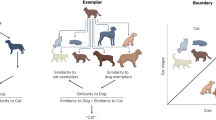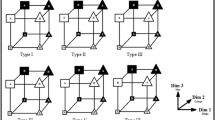Abstract
The problem of category learning has been traditionally investigated by employing disembodied categorization models. One of the basic tenets of embodied cognitive science states that categorization can be interpreted as a process of sensory-motor coordination, in which an embodied agent, while interacting with its environment, can structure its own input space for the purpose of learning about categories. Many researchers, including John Dewey and Jean Piaget, have argued that sensory-motor coordination is crucial for perception and for development. In this paper we give a quantitative account of why sensory-motor coordination is important for perception and category learning.
R.t.B and M.L: Work done at the Artificial Intelligence Laboratory in Zurich.
Access this chapter
Tax calculation will be finalised at checkout
Purchases are for personal use only
Preview
Unable to display preview. Download preview PDF.
Similar content being viewed by others
References
G.M. Edelman. Neural Darwinism: The Theory of Neural Group Selection. Basic Books: New York, USA, 1987.
R. Pfeifer and C. Scheier. Understanding Intelligence. MIT Press, Cambridge, MA, USA, 1999.
J.K. Kruschke. Alcove: An exemplar-based connectionist model of category learning. Psychological Review, 99:22–44, 1992.
B.C. Love and D.L. Medin. Sustain:A model of human category learning. In Proc. of the 5th National Conference on Artificial Intelligence (AAAI-98), pages 671–676, 1998.
A. Clark and T. Thornton. Trading spaces. Behavioral Brain Sciences, 20:57–90, 1997.
C. Scheier and R. Pfeifer. Information theoretic implications of embodiment for neural network learning. In Proc. of Int. Conf. on Articial Neural Networks, 1997.
J. Dewey. The reflex arc concept in psychology. Psychological Review, 3:357–370, 1981. Original work published in 1896.
E. Thelen and L. Smith. A Dynamic Systems Approach to the Development of Cognition and Action. MIT Press, Cambridge, MA, USA, 1994.
G.W. Snedecor and W.G. Cochran. Statistical Methods. Iowa State University Press, Ames, Iowa, USA, 1980.
P.R. Banerjee, S. Sibbald and J. Maze. Quantifying the dynamics of order and organization in biological systems. J. of Theoretical Biology, 143:91–112, 1990.
C.E. Shannon. A mathematical theory of communication. Bell Syst. Tech. J., 27:379–423, 623–653, 1948.
Author information
Authors and Affiliations
Editor information
Editors and Affiliations
Rights and permissions
Copyright information
© 2003 Springer-Verlag Berlin Heidelberg
About this paper
Cite this paper
te Boekhorst, R., Lungarella, M., Pfeifer, R. (2003). Dimensionality Reduction through Sensory-Motor Coordination. In: Kaynak, O., Alpaydin, E., Oja, E., Xu, L. (eds) Artificial Neural Networks and Neural Information Processing — ICANN/ICONIP 2003. ICANN ICONIP 2003 2003. Lecture Notes in Computer Science, vol 2714. Springer, Berlin, Heidelberg. https://doi.org/10.1007/3-540-44989-2_59
Download citation
DOI: https://doi.org/10.1007/3-540-44989-2_59
Published:
Publisher Name: Springer, Berlin, Heidelberg
Print ISBN: 978-3-540-40408-8
Online ISBN: 978-3-540-44989-8
eBook Packages: Springer Book Archive




